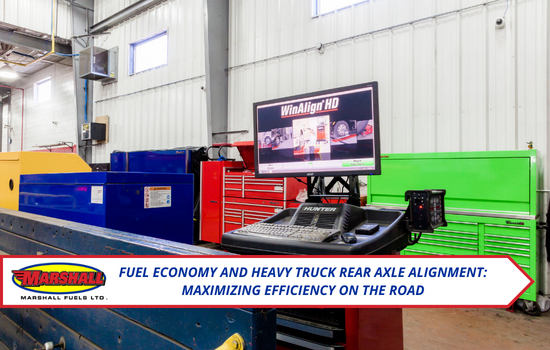In the world of heavy trucks, fuel economy plays a crucial role in overall operational efficiency. While various factors contribute to fuel consumption, one often overlooked aspect is rear axle alignment. Proper alignment of the rear axles in heavy trucks can have a significant impact on fuel economy.
Balancing Power and Efficiency: Fuel Economy and Heavy Truck Rear Axle Alignment
 Marshall Fuels is a 24-hour diesel fuel site that features a PetroPass Card Lock that’s conveniently located just off the QEW Niagara in Hamilton. In this blog, we will explore the connection between rear axle alignment and fuel efficiency, highlighting the importance of alignment for maximizing fuel economy in heavy trucks.
Marshall Fuels is a 24-hour diesel fuel site that features a PetroPass Card Lock that’s conveniently located just off the QEW Niagara in Hamilton. In this blog, we will explore the connection between rear axle alignment and fuel efficiency, highlighting the importance of alignment for maximizing fuel economy in heavy trucks.
Understanding Rear Axle Alignment
Rear axle alignment refers to the precise positioning of the rear axles in relation to each other and the frame of the truck. Proper alignment ensures that the axles are parallel to each other and perpendicular to the centreline of the truck. Alignment includes adjustments for the toe (inward or outward tilt) and thrust angle (alignment in relation to the truck's centreline).
Impact on Tire Rolling Resistance
Rear axle misalignment can lead to increased tire rolling resistance, resulting in higher fuel consumption. When the axles are misaligned, the tires do not roll smoothly and evenly. Instead, they scrub against the road surface, generating more friction. This increased resistance requires the engine to work harder, leading to less fuel economy.
Influence on Tire Wear
Misaligned rear axles can cause uneven tire wear patterns. As the tires scrub against the road surface due to misalignment, specific areas of the tire tread wear down faster than others. This irregular wear not only compromises tire lifespan but also negatively affects fuel economy. Unevenly worn tires create additional rolling resistance, increasing fuel consumption.
Effect on Truck Handling
Proper rear axle alignment contributes to better truck handling and stability. When the axles are aligned correctly, the truck tracks straight, requiring minimal steering input to maintain a straight course. Misaligned axles can result in a truck that constantly drifts or requires excessive steering correction. This inefficiency affects fuel economy, as constant steering adjustments create unnecessary drag.
Importance of Regular Alignment Checks
To maximize fuel economy, it is crucial to include regular rear axle alignment checks in your truck's maintenance schedule. A Marshall Truck & Trailer Repair technician can accurately assess and adjust rear axle alignment to ensure optimal fuel efficiency. They utilize specialized equipment called WinAlign® and follow manufacturer specifications to achieve precise alignment, minimizing tire wear and reducing rolling resistance.
Additional Benefits
Proper rear axle alignment not only improves fuel economy but also provides other benefits. These include enhanced tire life, reduced maintenance costs, improved truck control, and increased overall safety on the road. Aligning the rear axles of heavy trucks is an investment that pays off in multiple ways.
Properly aligned rear axles minimize tire rolling resistance, promote even tire wear, enhance vehicle handling, and reduce fuel consumption. Regular rear axle alignment checks and adjustments are essential for maintaining fuel economy and maximizing the overall performance of heavy trucks.
